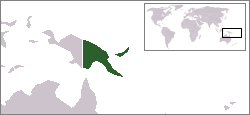Territory of Papua and New Guinea
| Territory of Papua and New Guinea | ||||||||||||
|
United Nations Trust Territory External territory of Australia |
||||||||||||
|
||||||||||||
|
||||||||||||
| Capital | Port Moresby | |||||||||||
| Languages | English (official) Austronesian languages Papuan languages English creoles |
|||||||||||
| Political structure | United Nations Trust Territory | |||||||||||
| Monarch | ||||||||||||
| • | 1949–1952 | George VI | ||||||||||
| • | 1952–1975 | Elizabeth II | ||||||||||
| Administrator High Commissioner |
||||||||||||
| • | 1949–1952 (first) | Jack Keith Murray | ||||||||||
| • | 1974–1975 (last) | Tom Critchley | ||||||||||
| Prime Minister | ||||||||||||
| • | 1949 (first) | Ben Chifley | ||||||||||
| • | 1949–1966 | Robert Menzies | ||||||||||
| • | 1972–1975 (last) | Gough Whitlam | ||||||||||
| Legislature |
Legislative Council (1949–1963) House of Assembly (1963–1975) |
|||||||||||
| Historical era | Cold War | |||||||||||
| • | Papua and New Guinea Act 1949 | 1 July 1949 | ||||||||||
| • | Self-governing | 1 December 1973 | ||||||||||
| • | Independence | 16 September 1975 | ||||||||||
| Currency | New Guinean pound (until 1966) Australian dollar (1966–1975) PNG kina (1975) |
|||||||||||
|
||||||||||||
The Territory of Papua and New Guinea was established by an administrative union between the Australian-administered territories of Papua and New Guinea in 1949. In 1972, the name of the Territory changed to "Papua New Guinea" and in 1975 it became the independent nation of Papua New Guinea.
Archeological evidence suggests that humans arrived on New Guinea around 50,000 years ago. These Melanesian people developed stone tools and agriculture. Portuguese and Spanish navigators sailing in the South Pacific entered New Guinea waters in the early part of the 16th century and in 1526–27, Jorge de Menezes came upon the principal island "Papua". In 1545, the Spaniard Iñigo Ortiz de Retes gave the island the name "New Guinea" because of what he saw as a resemblance between the islands' inhabitants and those found on the African Guinea coast. Knowledge of the interior of the island remained scant for several centuries after these initial European encounters.
In 1884, Germany formally took possession of the northeast quarter of the island and it became known as German New Guinea. In 1884, a British protectorate was proclaimed over Papua – the southern coast of New Guinea. The protectorate, called British New Guinea, was annexed outright on 4 September 1888 and possession passed to the newly federated Commonwealth of Australia in 1902 and British New Guinea became the Australian Territory of Papua, with Australian administration beginning in 1906.
The Australian Naval and Military Expeditionary Force seized German New Guinea and the neighbouring islands of the Bismarck Archipelago for the Allies in 1914, during the early stages of the First World War. At the 1919 Paris Peace Conference following the war, Australian Prime Minister Billy Hughes sought to secure possession of New Guinea from the defeated German Empire: telling the Conference: "Strategically the northern islands (such as New Guinea) encompass Australia like fortresses. They are as necessary to Australia as water to a city." Article 22 of the Treaty of Versailles provided for the division of Germany and the Central Powers' imperial possessions among the victorious Allies of World War I and German New Guinea, the Bismarck Archipelago and Nauru were assigned to Australia as League of Nations Mandates: territories "formerly governed [by the Central Powers] and which are inhabited by peoples not yet able to stand by themselves under the strenuous conditions of the modern world".
...
Wikipedia



